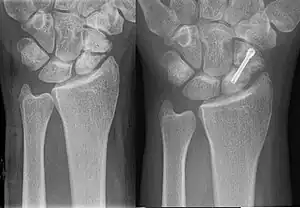Herbert screw

Scaphoid pseudarthrosis, before and after treatment with Herbert screw.
The Herbert screw (invented by Timothy Herbert) is a variable pitch cannulated screw typically made from titanium for its biocompatible properties as the screw is normally intended to remain in the patient indefinitely. It became generally available in 1978.[1][2] It is one of the earliest designs of headless compression screws which are used to achieve interfragmentary compression through its differential pitch between the threads at each end of the screw(distance between adjacent threads of screw).
It is used in scaphoid, capitellum, radial head and in osteochondral fractures. Other uses include osteochondritis dissecans & small joint arthrodesis.[3]
References
- ↑ S. L. Filan & T. J. Herbert: Herbert screw fixation of scaphoid fractures. J. Bone Jt Surg. 78-B, 519–529, 1996
- ↑ Tanja Mara Goldbrunner; Ergebnisstudie der operativen Versorgung von Scapoid-Pseudoarthrosen Archived 2012-03-09 at the Wayback Machine (Dissertation, Frankfurt am Main 2006 on the development and function of his screw)
- ↑ Thakur, Anand. J. (2007). The Elements of Fracture fixation. New Delhi: Elsevier. pp. 52–53. ISBN 978-81-312-2185-3.
This article is issued from Offline. The text is licensed under Creative Commons - Attribution - Sharealike. Additional terms may apply for the media files.